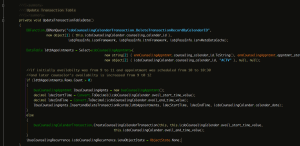Maintaining .net configurations across development, test and production regions have always been a problem that is faced. To ease this process, I was thinking of creating a utility that makes it easy to use and help deployments. The goal was to eliminate need to save and maintain multiple files for various regions. Here it is, “MergeConfig”
The utility uses ‘MergeConfig.xml’ as XML file to hold this information. The structure of this XML file is organized as:
- Deployment Region <deploymentRegion>
- File Info <fileInfo>
- Maintain Configuration <maintainConfig>
The Deployment Region specifies the name of the region, i.e. dev, test, prod.This section is to be defined one per region.
<deploymentRegion name="Development">
The File Info section specifies the file path that is to be merged. This section is defined one per region per file
<fileInfo fileName="D:\Project\App.config">
The Maintain Configuration section specifies what attribute to be replaced with what.
<maintainConfig findXPath="//root/configuration/add[@key='TestConfig']" replaceAttribute="value" replaceWith="ABC" />
Here the ‘findXPath’ attribute defines which element to look for in the configuration file. ‘replaceAttribute’ defines which attribute in the element has to replaced and ‘replaceWith’ defines the new value for that region. For example, consider the following in the App.config file
<root>
<connections>
<connection ID="main" connectionString="DataSource=DEV;Password=PWD;UID=UID" />
<connection ID="log" connectionString="DataSource=DEV;Password=PWD;UID=UID" />
</connections>
</root>
We would need to use,
<maintainConfig findXPath="//root/connections/connection[@ID='main']" replaceAttribute="connectionString" replaceWith="Data Source=localhost" />
The syntax for running this command line utility is:
MergeConfig.exe {/r | /region}: {/v | /verbose}
The switch /r specifies which region to use, and /v specifies if verbose output is required.
Examples:
MergeConfig.exe /r:Development /v
MergeConfig.exe /r:Development /verbose
MergeConfig.exe /region:Development
Click Download to get the compiled utility.










